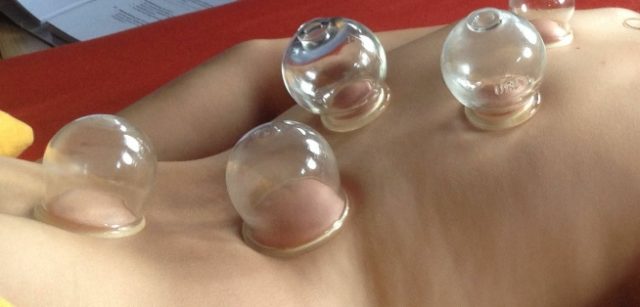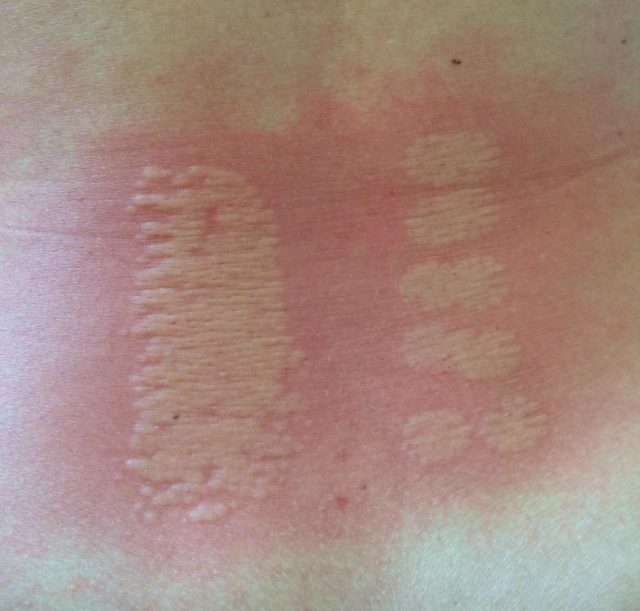Detoxyfying/cleansing procedures
- General Details
“If you find pain somewhere, know, that nature is seeking an outlet.” – Paracelsus
In the times before cellular pathology was promoted doctors worked with the a very different model, the humoralism. This is a system dating back to ancient Greece (approximately 400 B.C.) explaining bodily functions by defining the four humours: phlegm (mucus), melancholer (black bile), sanguis (blood), choler (yellow bile). These humours need to be produced by the body in an individual mixture. If the proportions are off, disease follows. Therefore the ‘bad humours’ need to be removed or the body must be stimulated to alter the mixture to restore the balance.
- Schröpfen
A vacuum is created in a cup which is then placed on the body. The stimulation of the blood flow results in an enhanced oxygen supply. Nutrients can reach the tissue and metabolic end-products, that need to be disposed of, are transported off.
Cupping removes local adhesion, stimulates the immune system and influences corresponding inner organs via cutivisceral reflexes.
This method is suitable for treating a number of ailments, such as chronic atony, trigger points, rheumatic disorders, myofascial pain, respiratory disease and insufficient blood flow, locally or within the corresponding organ.
Dry cupping does not cause any pain when skin and connective tissues are sucked up. However, the cups leave a bruise for a couple of days.
Wet or bloodily cupping involves pricking the skin with a lancet 5-7 times before applying the cup. It feels similar to having a blood sample taken from a finger. Through the suction, a few milliliters of blood per cup are extracted.
Wet cupping is employed to treat swellings (locally or within an inner organ) or to remove excess fluids, e.g. with certain types of gastritis, headache or high blood pressure.
Cupping massage – see Classic Massage
- Baunscheidtieren
The skin is first treated with a re-vitalisator (Lebenswecker), a tool devised by Carl Baunscheidt the inventor of this method. He called it an “artificial leech”. It is a set of needles that slightly scratch the outer layers of the skin. Next, an oil containing various etheric oils and histamine is applied, nettling the skin, thus creating a kind of artificial wheal similar to the effects of touching stinging-nettles. The creation of an artificial inflammation results in an increased flow of lymphatic fluids which improves the immune system, detoxifies the tissue and consequently reduces pain and infections.
Normally, the first sensation of stinging and burning lasts only for a short while. Occasionally moderate itching can arise. In very few cases a lasting hyperpigmentation of the skin might occur.
Baunscheidt therapy can be applied to treat a wide variety of diseases including shoulder-arm syndrome, arthrosis, neuralgic pain, rheumatic disorders, irritable bowel syndrome, premenstrual syndrome and others.
- Cantharidenpflaster
The Spanish fly (Lytta vesicatoria) is an insect but actually a beetle and not a fly. The dried and powdered beetles are made into a paste and applied to the skin for four to twelve hours causing an artificial inflammation. The resulting vesicle is filled with lymphatic fluid which is why this method is also called “white bleeding”. The vesicle is drained under aseptically conditions through a small incision and subsequently bandaged.
The excretory process helps to detoxify the tissue and kicks off a healing process. The blood flow is not only increased locally but also in the corresponding inner organ.
This method can be applied to treat afflictions of the musculoskeletal system (e.g. arthrosis, tennis elbow, lumbago etc.) or ORL (e.g. chronic otitis media or sinusitis, tinnitus, etc.).


